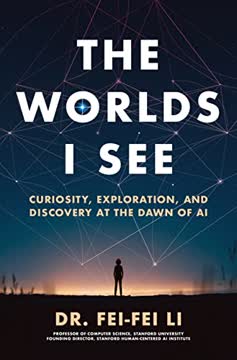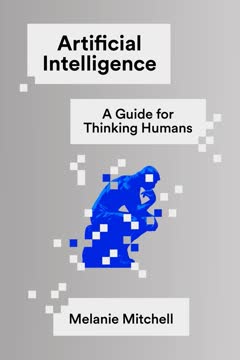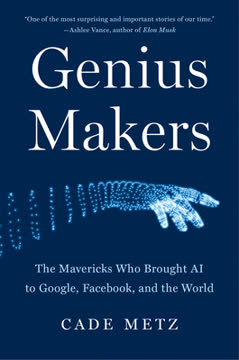Key Takeaways
1. AI is transforming business models and reshaping entire industries
Artificial intelligence is transforming the way firms function and is restructuring the economy
AI-driven transformation. AI is not just another technology trend; it's fundamentally changing how businesses operate and compete. Companies like Ant Financial, Ocado, and Peloton are leveraging AI to create new business models that challenge traditional industry boundaries. These firms are characterized by:
- Unprecedented scale and scope of operations
- Rapid learning and improvement through data analysis
- Removal of traditional operational constraints
Impact across sectors. The AI revolution is not limited to tech companies. It's reshaping industries as diverse as:
- Financial services (e.g., Ant Financial's AI-driven lending)
- Retail (e.g., Amazon's personalized recommendations)
- Healthcare (e.g., AI-powered diagnostics)
- Transportation (e.g., autonomous vehicles)
This transformation is forcing all companies to rethink their strategies and operations to remain competitive in the AI age.
2. The AI factory: A new core for digital operating models
The core of the new firm is a scalable decision factory, powered by software, data, and algorithms
Components of the AI factory. At the heart of AI-driven companies is the AI factory, consisting of:
- Data pipeline: Gathering, cleaning, and processing vast amounts of data
- Algorithm development: Creating predictive models and decision-making systems
- Experimentation platform: Testing and refining AI models in real-world scenarios
- Software infrastructure: Embedding AI capabilities into operational systems
Transformative potential. The AI factory enables companies to:
- Make faster, more accurate decisions at scale
- Continuously improve products and services through data-driven insights
- Create personalized experiences for customers
- Automate complex processes, reducing costs and increasing efficiency
Examples like Netflix demonstrate how the AI factory can drive business success, from content recommendations to production decisions.
3. Rearchitecting firms for the AI age requires fundamental changes
To use the full power of digital networks and AI, firms need a fundamentally different operating architecture
Shifting from silos to platforms. Traditional firms are often structured in functional silos, limiting data sharing and collaboration. AI-driven companies require a new architecture:
- Integrated data platforms replacing fragmented systems
- APIs enabling seamless connections between different parts of the business
- Modular, reusable software components for rapid innovation
Cultural and organizational changes. Rearchitecting goes beyond technology:
- Breaking down departmental barriers
- Fostering a data-driven decision-making culture
- Developing new skills and roles (e.g., data scientists, AI product managers)
Case study: Amazon's transformation. Amazon's journey from a siloed e-commerce company to an AI-powered platform demonstrates the challenges and benefits of rearchitecting:
- Bezos' mandate for service-oriented architecture
- Development of AWS as both an internal and external platform
- Continuous experimentation and learning across the organization
4. Becoming an AI company demands a holistic transformation approach
Balance conviction with patience.
Leadership and vision. Successful AI transformation requires:
- Clear strategic direction from top leadership
- Long-term commitment to change, despite short-term challenges
- Balancing AI initiatives with core business needs
Multifaceted approach. Becoming an AI company involves:
- Technology transformation:
- Building AI capabilities and infrastructure
- Modernizing legacy systems
- Organizational change:
- Restructuring teams for agility and cross-functional collaboration
- Developing AI talent and reskilling existing workforce
- Business model innovation:
- Identifying new AI-enabled products and services
- Reimagining customer experiences and value propositions
Microsoft's AI journey. Under Satya Nadella's leadership, Microsoft transformed into an AI-first company by:
- Shifting to cloud-based services (Azure)
- Integrating AI across product lines
- Embracing open-source technologies
- Fostering a growth mindset culture
5. AI-driven strategies focus on network effects and data advantages
The more data that is generated, the better the services the organization can provide and the more incentive there is for third parties to plug in.
Network effects in the AI age. AI amplifies traditional network effects:
- More users generate more data, improving AI models
- Better AI models attract more users, creating a virtuous cycle
Data as a strategic asset. Companies must focus on:
- Acquiring unique, valuable datasets
- Creating data network effects (e.g., user-generated content)
- Leveraging data across multiple applications and industries
Strategic considerations:
- Multihoming: How easily users can switch between platforms
- Data moats: Building defensible data advantages
- Platform control: Balancing openness with value capture
Examples:
- Google's search dominance driven by continuous data-driven improvements
- Ant Financial's expansion from payments to a broad financial services ecosystem
6. Strategic collisions between AI-powered and traditional firms are reshaping markets
After digital technology collides with traditional photography, it does not simply replace it with something cheaper, more differentiated, or higher quality. It does not merely create a new value proposition to serve customers. It enables the emergence of a new and increasingly powerful breed of company, one that leverages a different kind of operating model and competes in different ways.
Dynamics of collision. When AI-powered firms enter traditional markets:
- Initial disruption: New entrants challenge incumbents with AI-driven efficiency and personalization
- Rapid scaling: AI firms grow faster due to network effects and data advantages
- Industry transformation: Traditional business models become obsolete, forcing adaptation or exit
Case studies of collision:
- Smartphones: Apple and Google's software platforms vs. Nokia's hardware focus
- Retail: Amazon's AI-driven personalization vs. traditional brick-and-mortar stores
- Transportation: Uber's dynamic pricing and matching vs. traditional taxis
Incumbent responses:
- Digital transformation: Adopting AI and data-driven approaches
- Partnerships and acquisitions: Collaborating with or acquiring AI-native companies
- Focusing on complementary strengths: Leveraging unique assets or relationships
7. The ethics of AI: Navigating amplification, bias, security, and equity challenges
The power of platforms like YouTube and Baidu to propagate and target information is also what makes them an engine for weaponizing misinformation and stoking bias.
Ethical challenges of AI:
- Digital amplification: AI systems can rapidly spread misinformation or harmful content
- Algorithmic bias: AI models can perpetuate or exacerbate existing societal biases
- Cybersecurity: AI-powered systems create new vulnerabilities and attack vectors
- Platform control: Balancing openness with responsible governance
- Fairness and equity: Addressing AI's potential to increase economic inequality
Responsibility of AI leaders:
- Proactive ethical governance: Developing clear AI principles and guidelines
- Diverse and inclusive AI development: Ensuring representation in data and teams
- Transparency and accountability: Providing explanations for AI decisions
- Collaboration with regulators and stakeholders: Shaping responsible AI policies
Examples of ethical challenges:
- Facebook's struggle with fake news and political manipulation
- Gender and racial bias in AI-powered hiring systems
- Privacy concerns with facial recognition technologies
8. A new meta: AI is changing the rules of business and society
The age of artificial intelligence is changing the game for all of us. But this new meta isn't characterized by robots acting like humans. It's all about the emergence of a new type of firm, one that uses AI in a much subtler way to break down age-old operational constraints, driving new value, growth, and innovation.
Fundamental shifts:
- Systemic change: AI impacts all industries simultaneously, not in isolated waves
- Universal capabilities: AI-driven skills becoming more important than industry-specific knowledge
- Blurred industry boundaries: AI enables easy entry into adjacent markets
- Frictionless impact: AI removes traditional operational constraints, enabling rapid scaling
- Increased concentration: Network effects and data advantages lead to winner-take-most dynamics
Implications for leaders:
- Continuous transformation: Embracing ongoing change as the new normal
- Ethical leadership: Balancing innovation with responsible AI deployment
- Ecosystem thinking: Collaborating across traditional industry boundaries
- Lifelong learning: Developing AI literacy and adaptability at all levels
Societal considerations:
- Job displacement and reskilling: Preparing for AI's impact on the workforce
- Regulatory challenges: Developing flexible, adaptive governance frameworks
- Digital divide: Addressing potential inequalities created by AI adoption
The AI revolution demands a new type of wisdom from leaders, combining technological understanding with ethical foresight and a commitment to shared prosperity.
Last updated:
FAQ
What's Competing in the Age of AI about?
- AI's Transformative Impact: The book explores how AI is reshaping businesses and the economy, transitioning from traditional to AI-driven models.
- New Operating Models: It emphasizes the need for companies to adopt scalable, data-centric operating architectures to leverage AI effectively.
- Strategic Frameworks: Provides frameworks for leaders to navigate the AI landscape, crucial for both digital and traditional firms.
Why should I read Competing in the Age of AI?
- Understanding AI's Role: Gain insights into AI's profound impact on business strategy and operations.
- Practical Frameworks: Offers actionable frameworks and case studies for adapting to the AI era.
- Future-Proofing: Helps prepare organizations for AI-driven challenges and opportunities, essential for staying competitive.
What are the key takeaways of Competing in the Age of AI?
- AI as Core: AI is becoming the operational foundation, changing how businesses deliver value.
- Rethinking Models: Companies must rethink business models to fully leverage AI's potential.
- Strategic Collisions: Highlights competitive dynamics between traditional and AI-driven firms, emphasizing adaptation.
What are the best quotes from Competing in the Age of AI and what do they mean?
- AI as 'Runtime': AI is foundational, shaping future business operations and strategies.
- Optimizing Digitization: Aligning structure with digital capabilities maximizes growth and adaptability.
- Rethinking Strategy: Traditional strategies need reevaluation in light of AI's transformative power.
How does Competing in the Age of AI define an "AI factory"?
- Scalable Decision Engine: An AI factory powers digital models, integrating data and decision-making.
- Process Automation: Embeds managerial decisions in software, reducing human intervention.
- Virtuous Cycle: User engagement improves algorithms, enhancing learning and adaptation.
What are network effects and why are they important in Competing in the Age of AI?
- Value Increase: Network effects occur when a product's value increases with more users.
- Competitive Advantage: Harnessing network effects creates barriers to entry and enhances engagement.
- Practical Examples: Companies like Facebook exemplify strong network effects, crucial for digital success.
How do learning effects contribute to a company's success according to Competing in the Age of AI?
- Performance Improvement: Learning effects improve performance as companies accumulate data.
- Amplifying Advantage: Enhances competitive advantage by refining offerings and meeting customer needs.
- Real-World Application: Companies like Google use learning effects to continuously enhance user experiences.
What role does leadership play in the age of AI according to Competing in the Age of AI?
- Guiding Transformation: Leaders must navigate digital transformation complexities, fostering a culture of change.
- Ethical Challenges: Addressing AI's ethical issues, like bias and privacy, is crucial for responsible leadership.
- Vision and Strategy: Leaders need a clear vision for AI integration, aligning the organization towards common goals.
What are the ethical challenges associated with AI as discussed in Competing in the Age of AI?
- Algorithmic Bias: AI algorithms risk bias, leading to unfair outcomes; fairness is essential.
- Data Privacy: Protecting user privacy is critical as firms collect vast data.
- Accountability: Establishing guidelines for responsible AI usage and decision-making is necessary.
How can companies become AI companies according to Competing in the Age of AI?
- Strategic Commitment: Prioritize AI and data integration with a clear transformation strategy.
- Building Capabilities: Invest in data science and AI talent to foster innovation.
- Agile Approach: Embrace agile methodologies for rapid AI application deployment.
How does Competing in the Age of AI suggest companies can capture value in a digital economy?
- Optimize Pricing: Use data to understand customer willingness to pay and tailor offerings.
- Two-Sided Markets: Leverage two-sided networks for flexible monetization strategies.
- Innovative Models: Explore subscription or outcome-based pricing to align with customer needs.
What challenges do companies face in the age of AI as described in Competing in the Age of AI?
- Disintermediation Risks: Users bypassing platforms can undermine value capture.
- Multihoming Behavior: Users engaging with multiple platforms challenge brand loyalty.
- Ethical Considerations: Navigating AI's ethical issues is crucial for trust and sustainability.
Review Summary
Competing in the Age of AI receives mixed reviews. Many praise its insights on digital transformation and AI's impact on business, calling it essential reading for leaders. The book explores how AI is reshaping industries, offering strategies for companies to adapt. However, some criticize it for being repetitive, overly academic, and lacking depth in technical explanations. Reviewers appreciate the case studies but note that some examples may already be outdated. Overall, it's seen as a valuable resource for understanding AI's role in business, despite its flaws.
Similar Books









Download PDF
Download EPUB
.epub digital book format is ideal for reading ebooks on phones, tablets, and e-readers.




